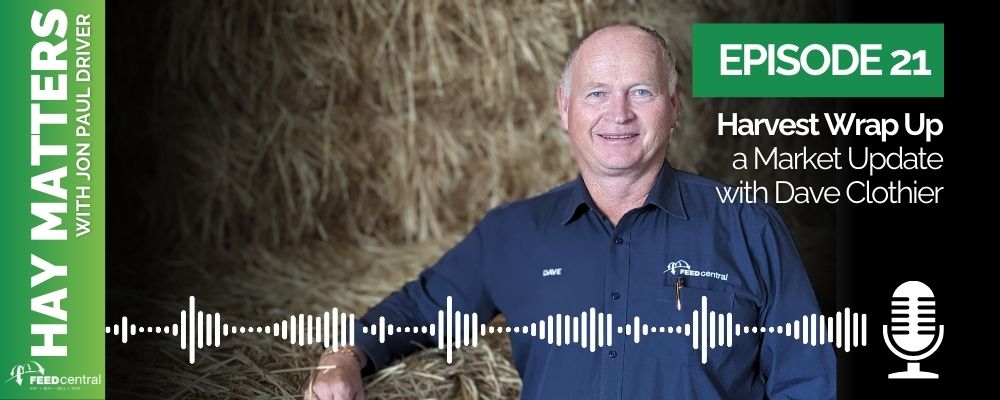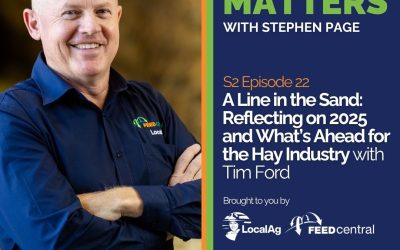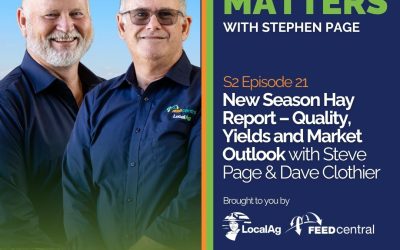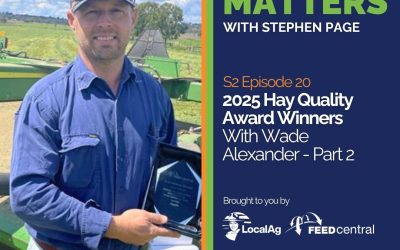
In this market update episode of the Feed Central Hay Matters Podcast, host Jon Paul Driver and Dave Clothier discuss the state of the Australian hay market as the harvest season winds down. They explore how recent weather events have affected hay quality and yields across different regions, with a range of grades now available. The episode also touches on the high demand from the beef sector, pricing across the different regions, and considerations for buyers looking to secure quality hay in light of potential supply shifts in the coming months.
- Hay production in Queensland is mostly complete, with limited shed availability there is a higher proportion of paddock stacks.
- New South Wales and Victoria are nearing completion, although recent rain has affected quality, resulting in variable quality and the majority of sheds now full.
- In South Australia and Western Victoria, drought and frost have reduced yields by 30-50% compared to last year, causing significant losses for some growers.
- Recent storms and wet conditions have delayed harvests in the north, leading to bleached, lower-grade hay with thicker stems and higher NDF. Overall, high-quality hay volumes are down, as adverse weather and frost have pushed many high-yielding crops toward grain production instead of hay.
- High canola prices mean fewer frosted canola crops were turned into hay, contrary to initial expectations.
- Limited vetch planting this season has reduced supply, driving up demand for lucerne and other protein-rich hays, with prices expected to remain firm.
- Prices are steady across regions, with FCA grade cereal hay around $250 per tonne, likely holding through Christmas. Many producers are holding back supply in anticipation of stronger demand and firmer prices in early 2025.
- The beef sector’s demand for hay is strong due to herd growth and export opportunities, while the dairy sector is purchasing more cautiously given the variable hay quality and limited protein-rich options.
- Buyers are advised to secure supplies now to access the broadest quality selection at stable prices, avoiding potential price increases and compromised quality in early 2025.
- With high-demand periods likely through the summer and autumn periods, it’s important to factor in both quality and location to optimise the best delivered pricing.
Read Transcript
Jon Paul Driver 0:00
Welcome to the Feed Central Hay Matters podcast. I’m your host, Jon Paul driver, today I’m joined by Dave Clothier. He’s the National Sales Manager for Feed Central. Welcome to the podcast.
Dave Clothier 0:15
Great to be here again. Thanks, JP, seems like an eternity since we last spoke.
Jon Paul Driver 0:19
Well, you’ve been to … is it Beefex?
Dave Clothier 0:22
Two weeks ago? Yeah, that’s right.
Jon Paul Driver 0:24
And then, of course, we’re I mean, on the tail end of hay season, let’s talk about supply first. What’s it look like, region by region?
Dave Clothier 0:33
Okay, thanks. JP, it’s still unfolding. There’s still a little bit to go in the south, but largely the hay making season has finished just starting in the north. Like the grain harvest is well underway now, although it’s been upset by some recent weather events, so that’ll slow things down a little bit. Hay productions largely finished up here. Some of it found some local homes, but with the North, you know, we are challenged by shed availability. So there is lots of paddock stacks out there. And they have their own challenges, especially as we have entered into our wet season, so to speak, with the storm season well underway over recent days, northern and central New South Wales, mostly, that’s mostly made or on the ground, and sheds are pretty full with the dedicated hay growers, the opportunists have certainly had a crack, not to the scale or the hype in the industry that has been vocalized over recent months. We’ll talk about a bit a bit more about that later on, Southern New South Wales and Vic productions either completed or underway. There has been a lot of hay on the ground over the last few weeks, and it has had quite a bit of weather on it. So there has been a challenge with with quality hay production. But that’s okay, because the industry needs all grades of a and feed central particularly manages that job very well through our platform and our lab South Australia and Vic like they continue to be challenged. The yields are well back, depending on who you talk to. You know, it’s 30 to somewhere between 30 and 50% of the production from last year. So it’s well back. They’ve had some recent rain, but it’s done a little too, too late for that, yeah, and hey, crap, yeah, yeah, too late for that. But it’s done little for the local demand perspective as well, because the pasture growth that just hasn’t come there. So yeah, they’re still struggling. I think the overarching thing really is the recent weather events have certainly affected the quality of hay with reasonable volumes across all grades. So which is something the industry needs, but just the challenges of these recent weather events have either damaged it in the windrow, or they’ve prevented harvest to the point that the crops matured, resulting in a lower grade of product at the end of the day. That’s been a big one. There was a lot of hype, you know, about six weeks ago, of huge volumes of frosted crops going to hay production. I think it doesn’t matter who you speak to in the industry right now, most of the hay producers particularly realize that that just hasn’t come to fruition. A number of factors contributing there. It all came at once. There wasn’t enough contractors in the system to be able to bail the product through the window that that there was with a lot of the crops being so high yielding, even with frost damage, they still were taken through to grain. Oh, really, yeah, there was a lot of talk about a lot of Canal fail canola crops going to hay production. That certainly hasn’t come to fruition. I’m not saying there hasn’t been some made, but with canola prices, like, if there was anything, anything worthwhile harvesting, they certainly did rather than going to hay production. So the canola production, certainly, from a hay perspective, just didn’t come about. And that’s a pretty strong message to the industry. Really, what did there’s just not the quality, the volume of quality high that we would have predicted, you know, last time we spoke to AP, not saying it’s not there, but just not the volume.
Jon Paul Driver 4:38
And take me through the overlap between the drought affected region and the frost affected region. What geographies are we talking about, and how did that interact?
Dave Clothier 4:48
Well, if we go down to South Australia and Western Vic, they actually they copped it from both. They were certainly the crops. Those were drought affected. And then right towards the end, they had the big frost impact as well. And there were some pretty serious losses to some of those growers down there. If we get into the New South Wales area enjoying good seasons, like there’s good pasture growth around and high yielding crops that the frost had an effect on. But because of the status of the crops, there was enough volume there to take through to grain, which is what they’ve largely done. There’s still some frosted crops that are either on the ground now or going to be cut in the next, sort of seven to 10 days, but that’ll be about the end of it. Otherwise, the crops too mature anyway, for production, hay production, the other thing I should just say, from a protein hay perspective, there is very little vetch sown for this season. And what vetch was out there, we’ve seen lower yields than we’ve done in the done in previous years. And the quality, although there are some very good quality Vetches out there, there is a reasonably low supply of vetch, which obviously affects particularly the dairy sector. But that’s something to be mindful of. And the loose in production as well. In that other protein space, we can see that that is going to continue to be in reasonably high demand, which will help firm up prices in that space.
Jon Paul Driver 6:31
Yep, we’re not seeing the volume of hay that we would have thought would come six weeks ago when the frost events hit, and then what has been harvested is of varying quality, not not bad or particularly good, but variable depending on region and when the rain hit.
Dave Clothier 6:51
Yeah, yeah. Because of the weather, what we’ve seen is hay left the windrow longer than we would have liked, so there’s more bleaching, just a downgrade in general quality. Yeah, thicker stems because of the maturity, because of the season we’ve had, yep, yep, and that’s what we’re seeing.
Jon Paul Driver 7:10
Lower fiber digestibility, just not as good a hay, right?
Dave Clothier 7:14
Yeah, higher NDF than we saw last season. You know, tip in those cereal hays, where we saw those sort of 50s or low 50s last year, like they’re probably in the mid 50s to a little bit higher than that we’ve seen this year so far through our lab. Now on the demand side, a generalized statement because of the season that we’ve been enjoying through the majority of the eastern seaboard, apart from Western Vic and South Australia. And, you know, western parts of New South Wales and Queensland are starting to suffer too as temperatures rise. But generally the market has been very slow. And I think a function of that is, you know, pasture availability number one, but the other one, I think, is this hype around this massive stockpile of hay that was going to be produced and that would drive prices further. I think the reality of it is that we’re at a point in time where we’ve we’ve got the best opportunity to buy right now, because we’ve got the greatest selection of this year’s production on the shelf, so to speak. And I don’t think the consumers or the buyers are fully aware of that at this point. So there’s people holding there’s people holding back, thinking that the market’s going to go down right now, talking to some pretty serious producers across the cut, right across the country, like our feeling at the moment is, is the price is stabilized, and it will continue to remain roughly where it is through to the Christmas period, the dedicated hay growers are releasing product to the market, recouping production costs, and a lot of them are wanting to sit on their product where they’ve got the ability to shed the product, manage it, and wait for demand to increase. There’s a there’s a lot of that talk within the industry, and I can fully appreciate that. I’ve only been in this role for three years, but something I’ve seen that I haven’t seen the years I’ve been here and talking to other people in the industry, an anomaly is that the price is pretty much static across New South Wales and Vic and South Australia, particularly like an A grade cereal hay is making $20 either side of 250 bucks. That’s a static number that everybody seems to appreciate, that that’s where it is at the moment.
Jon Paul Driver 9:47
Slight variances on barn stored or covered, or the distance to ship, right?
Dave Clothier 9:53
Yeah, I think the price similarity across the industry. I. Reflects the demand moving forward. I think, in that, you know, we’re going to see demand lift again through circumstances in that Western Vic and South Australia job, just because of the low yields, the empty sheds going into the season, like I think those southern, New South Wales and Victorian producers, they can move that hay across that way, or they can move it north. So the demand I feel is going to be pretty even either way. And I think that’s the reasoning in my head about why the numbers pretty much the same across the board
Jon Paul Driver 10:38
Anything special going on in livestock markets. Rather, let me try that again. You were at Beefex what did you learn there?
Dave Clothier 10:47
Look, it continues to improve every year. But the Beefex event, it was very professionally run. There was a high level of confidence about where the industry is at and the export opportunity for the beef sector continues to be strong. Our standards in the in the grain fed industry are exceptional, like they are world class, and because of what’s happening in the US as you’re well and truly aware of the opportunity for the export side of the beef industry remains very strong and will continue to remain strong in Australia. So the continued investment in technologies and supporting young people coming through the business, the continued expansion across the feedlot sector and the confidence that continues in that space augurs very well. I think for the fodder industry, the more cattle I get to feed, obviously, the better it is for hay producers. So that’s very confident. The national herd is still very strong. So that guarantees supply into the feedlot sector for the foreseeable future, so that part of it is very healthy. From that standpoint, pastures are so strong across the majority of New South Wales and Queensland. I I imagine that we will see records show that there’s going to be high pregnancy rates, high branding rates, high weaning weaning numbers, all those sort of thing to support the positive nature of the industry moving forward from a supply perspective, and We’re also seeing a forecast wet into spring and through to summer, through to next February, really, which certainly gives people confidence about supply going forward from the livestock perspective, and prices are still very healthy.
Jon Paul Driver 12:53
And sheep and dairy?
Dave Clothier 12:56
Sheep are still very strong, and I can’t see much of a change there in the foreseeable future, the dairy sector have taken a hit in recent times, and they are managing their purchase decisions more closely than ever. But that’s nothing new. In the dairy sector, they tend to look at their feed tests and manage their purchase decisions a lot more closely than the other livestock sectors, and so they should, but they will be challenged by the variable grades that have been produced through this year’s hay season, so it will be a challenge to find the right product at the best delivered price. So they will be watching very closely. They’re already challenging us with finding suitable quality and volumes of vetch, which we’re trying to get the industry to understand that there just is not that volume there that the hype was around, you know, a month or six weeks ago. It just wasn’t planted. To be honest, the the the vet in the same volumes it was in previous years.
Jon Paul Driver 14:04
And any commentary on the export market, I’m just looking at the Australian dollar dropping to… from an American perspective, that’s actually terrible news. I think about it backwards, probably, but 65 cents to buy an Australian dollar.
Dave Clothier 14:18
Look what we’re saying, like there was some activity from exporters early, early in the season. And that’s when all the hype was out there about these massive volumes of hay production and quality, like high quality volume. So they, from what I understand, they they went pretty quiet first for a space, a space in time, and they’re just lifting the activity again, largely, it’s supported by the same numbers that we spoke about earlier. From what I understand, you know that that 250 give or take because they’re you know from recent conversations. You know that 290 sort of delivered is the number I’m hearing at the moment. Some of it’s a little bit further north than that, but I would appreciate that may strengthen once, once that hay production is totally complete, and there’s a clear understanding of what this stockpile looks like. But I think the reality is there is not those volumes of quality cereal hay out there that were expected. There are larger volumes of what we would call a FCB grade type product, where it’s sat in the window a bit longer, it’s had bleaching, or it’s had a fall of rain on it, or any of those factors that that affect the quality from from a feed central perspective, I think a message that we’re having every single day all of our account managers, is trying to explain to our customers that we are at a point in time where there’s the greatest opportunity to find the right product for their needs, and we’re trying to get people to think about when demand is going to be in their particular enterprise, and to find the right product now and secure it for the future. Because the there isn’t that huge volume of quality hay out there, there’s still, there’s no need to panic by any means. You know, buying fodder as a function of two thingsor and one is to find the right quality, and the other is to find it in the right location to achieve the best outcome from a delivered price. So if we are starting to wait until the New Year or after that sort of thing, when we’re getting close into weaning, and all those types of events here in Australia, if we wait to make our purchase decision then the reality, I think, is it’s just going to be further away from where they are now, and possibly they may have to accept the lower quality than what they could achieve today. I think now is the time for our customers to reach out to us and at least have the conversation and understand what’s in the market today and make their purchase decisions based on facts.
Jon Paul Driver 17:15
You just gave advice to hay buyers, what would you give any different advice to hay sellers?
Dave Clothier 17:22
Because demand is so low, and we like this time last year, we had that forecast El Nino type event where we were going to go into a dry summer, and people panicked, and there was product being bought out of the back of balers that just hasn’t eventuated this year from a demand perspective and all that hype out there about this huge volume of product hasn’t eventuated to the extent that was forecast. So from a from a seller perspective, our advice and what the bigger growers are doing anyway is they’re releasing a volume of product onto the market at the market price today, which we’ve covered, that 250 either side of 20 bucks, and recoup their harvesting costs or their baling costs, and then play the longer game going into early next year. And that’s what our growers are telling us. So again, from a buying perspective, it’s a sort of a call to action. From the buyers perspective, that if they don’t take the opportunity to secure the right product now, and I’m talking within the next, sort of four to six weeks, running up to Christmas, I think they’re going to be paying more, and they may not be getting the same grade of product that they could buy today, if we talk about dollars per megajoule or similar type scenarios, sure, I suppose the only unknown that I haven’t bought up like we’ve spoken about a protein shortage, you know, very little batch production and protein hay just generally being in short supply, the unknown at the moment, but my gut tells me that there’s going to be an opportunity for a volume of dry land lucerne particularly through New South Wales. Like that could assist the market from a demand perspective going forward, but that one will just have to wait and see. You know, what transpires through November and December?
Jon Paul Driver 19:28
Is the cereal hay, a competitive product or a complimentary product to the protein hay.
Dave Clothier 19:34
It’s a it’s a complimentary type product, depending on the enterprise and the circumstances that the buyer demands depends on their business needs. From a dairy perspective, it depends on the volume and quality silage that they’ve produced that has an effect on whether they need a cereal type hay or a protein type hay. So. If we’re talking about in the beef sector, if it’s, you know, if it’s a weaning type scenario, a high protein hay with a really good aroma and green, soft hay is what they’re looking for. If it’s a maintenance type ration, that’s where you can come back into your lower grades, generally speaking. And an induction type period through a feed lot, they are looking for those aromas, you know, soft, high quality hays is what they’re looking for through any of those educational type scenarios within the livestock sector. And that’s the one I think there needs to be some action on in the in in the coming, you know, six to eight weeks leading up to Christmas. Lookm those critical points through production of weaning type scenarios, or inducting cattle into a feed light, or sheep into a feed lot, that type of thing, that aroma and quality of product is paramount. That’s the most important thing. It is reasonably interesting. At the moment, I think we might see hays firming up because of supply. But right now, in certain areas like that, that cereal quality, cereal hay and reasonably well testing, lucerne hays are at parity. So I think people need to look at that, because there’s always an assumption that protein hay is going to cost me more. I think now’s the time to study the market. Reach out to somebody like Feed Central and speak to people in the game to understand what are the best outcomes for my own situation in business.
Jon Paul Driver 21:43
Now, Dave, what I just heard you say there you might be thinking that protein hay prices could firm up and that now would be a good time to at least take a look at it for your business.
Dave Clothier 21:54
Certainly, absolutely, that is 100% spot on.
Jon Paul Driver 21:59
That’s a great takeaway, Dave, thank you for joining us again Dave, as as always, your insights are wonderful, and no doubt will help folks.
Dave Clothier 22:07
Thanks very much JP, look forward to catching up again once or twice between now and Christmas.
Jon Paul Driver 22:13
I’ve been joined by Dave Clothier, National Sales Manager for Feed Central. A big thanks for our regular guest today for sharing valuable insights. This podcast is proudly presented by Feed Central. Stay tuned in for upcoming episodes.



